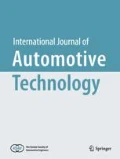Abstract
The assessment of vehicle dynamic comfort to human body vibration varies from person to person. Even though the dynamic comfort rating can be obtained by placing measurement devices over the cabin, passengers may have dissimilar sensations. For many car manufacturers, both subject and objective measurements are used together at development of new cars. To effectively assess the dynamic comfort of vehicle, this research explores the correlation between the objective measurement of the whole body vibration, hand-transmitted vibration and subjective assessment. The whole body vibration is measured from the backrest, seat surface and vehicle floor, whereas the hand-transmitted vibration is measured from the steering wheel. Four different vehicles are driven at various speeds on five types of pavements. Both simple linear regression and polynomial regression models based on Stevens’s power law from psychophysics are built to correlate the subjective and objective data. The regression results show that (1) the seat surface is more reliable than other positions for assessing the human body vibration; (2) the hand transmitted vibration on rough roads is more trustful for dynamic comfort evaluation than on smooth roads; (3) the overall dynamic comfort value is the most reliable index for dynamic comfort evaluation.
Similar content being viewed by others
References
Ebe, K. and Griffin, M. J. (2000). Quantitative prediction of overall seat discomfort. Ergonomics 43, 6, 791–806.
Ebe, K. and Griffin, M. J. (2001). Factors affecting static seat cushion comfort. Ergonomics 44, 10, 901–921.
Glantz, S. A. and Slinker, B. K. (1990). Primer of applied regression and analysis of variance. McGraw-Hill, New York.
Griffin, M. J. (2004). Minimum health and safety requirements for workers exposed to hand-transmitted vibration and whole-body vibration in the European Union: a review. Occupational and Environmental Medicine 61, 5, 387–397.
Griffin, M. J. (2007). Discomfort from feeling vehicle vibration. Vehicle System Dynamics 45, 7–8, 679–698.
Griffin, M. J. (2015). Predicting and controlling risks from human exposures to vibration and mechanical shock: flag waving and flag weaving. Ergonomics 58, 7, 1063–1070.
GB/T 4970-2009 (2009). Method of running test — automotive ride comfort. National Standardization Committee.
Heiberger, R. M. and Neuwirth, E. (2009). Polynomial Regression. R Through Excel, Springer, New York.
Huang, B., Jiang, Z. H and Yan, J. (2001). Survey on research of vehicle seat dynamic comfort. Automobile Science & Technology, 6, 13–16.
ISO 2631-1. (1997). 2631-1: Mechanical vibration and shock evaluation of human exposure to whole-body vibration — Part 1: General requirements. Geneva, Switzerland:ISO.
ISO 5349-1 (2001). 5349-1: Mechanical vibration-measurement and evaluation of human exposure to hand-transmitted vibration — part 1: general requirements.
Kim, M. S., Kim, K. W. and Yoo, W. S. (2011). Method to objectively evaluate subjective ratings of ride comfort. Int. J. Automotive Technology 12, 6, 831–837.
Lin, K. Y., Huang, J. R., Chang, J. M. and Doong, J. L. (2011). Development of a ride comfort evaluation method with a laboratory testing system. Int. J. Vehicle Design 57, 3, 162–177.
SAE J1060 (2014). Subjective rating scale for evaluation of noise and ride comfort characteristics related to motor vehicle tires. Society of Automotive Engineers.
Sedgwick, P. (2013). Simple linear regression. BMJ, 346.
Stevens, S. S. (1987). Psychophysics: Introduction to its perceptual, neural, and social prospects. American J. Psychology 88, 4, 677.
Wang, F. and Easa, S. (2016). Analytical evaluation of ride comfort on asphalt concrete pavements. J. Testing and Evaluation 44, 4, 1671–1682.
Yoo, W. S., Na, S. D. and Kim, M. S. (2011). Relationship between subjective and objective evaluations of steering wheel vibration. J. Mechanical Science and Technology 25, 7, 1695.
Yusuf, F., Martins, J. M. and Swanson, D. A. (2014). Demographic Information. Springer, Netherlands.
Zhang, Z. F., Xu, Z. M. and He, Y. S. (2010). Objective evaluation methods of automobile riding comfort [J]. J. Chongqing University 33, 4, 14–20.
Zhou, Z. and Griffin, M. J. (2014). Response of the seated human body to whole-body vertical vibration: discomfort caused by sinusoidal vibration. Ergonomics 57, 5, 714–732.
Acknowledgement
The authors would like to thank the Guangzhou Automobile Group for their great help with experiments. And this research is funded by the University of Macau (File nos. MYRG2019-00028-FST and MYRG2020-00045-FST); the Natural Science Foundation of Guangdong Province of China (2019A1515011602 (EF009/FST-WPK/2019)). This work is also supported by the Opening Project of Guangdong Provincial Key Lab oratory of Technique and Equipment for Macromolecular Advanced Manufacturing, South China University of Technology, China (Grant No. 2019kfkt06).
Author information
Authors and Affiliations
Corresponding author
Additional information
Publisher’s Note
Springer Nature remains neutral with regard to jurisdictional claims in published maps and institutional affiliations.
Rights and permissions
About this article
Cite this article
Ao, D., Wong, P.K., Huang, W. et al. Analysis of Co-Relation Between Objective Measurement and Subjective Assessment for Dynamic Comfort of Vehicles. Int.J Automot. Technol. 21, 1553–1567 (2020). https://doi.org/10.1007/s12239-020-0146-0
Received:
Revised:
Accepted:
Published:
Issue Date:
DOI: https://doi.org/10.1007/s12239-020-0146-0



